Google Analytics is a tool that any blogger (or webmaster) may need to know how to use.
At first, when you are unfamiliar, the Google Analytisc parameters will make you feel confused, even if you do not understand what the parameters say.
But to say that reading the parameters in Google Analytics is extremely important, the statistics will tell you how many people are currently online on the blog, where they are reading, where they come from. , how old…
If properly used and utilized, all of this data will help you in developing content and marketing strategies that are very effective.
So in this article Ngoc will share with you how to understand the meaning of the most important parameters in Google Analytics and how to use these parameters to develop your blog.
WHAT IS GOOGLE ANALYTICS & WHAT ARE THE MOST IMPORTANT PARAMETERS
Google Analytics is a tool for bloggers and webmasters to track statistics about blog / website data. This is a totally free tool provided by Google.
Basically, you can understand that if you use Google Analytics, you know exactly how many people are online at this time (or in the past) how many people are online on your blog, How do they read your blog, how, where they are, what their hobbies are, how old they are, where they live.

Note: Google Analytics will not automatically integrate into your blog, so you'll need to install Google Analytics ( see this tutorial ). This is extremely simple and the operation takes about 5 minutes. Ngoc recommends installing Google Analytics as soon as possible.
IMPORTANT PARAMETERS IN GOOGLE ANALYTICS
Let's say that one of the factors that we often "bored" Google Analytic because it has too many parameters.
If you want to see all of these parameters, you will probably spend hours, so there are some important concepts and parameters that you will need to follow.
Key concepts:
- Users: Also known as audiences, these are people who visited your blog at least once in the time range you were viewing the report. The number of users here includes both new and returning visitors (back).
- Sessions: A session is defined as the amount of time that a user is interacting (visiting) on your blog.
- Demographics: These are detailed statistics about user objects. For example, gender, age, interests ...
- Bounce Rate: This is the percentage of users who visit only one page, that is, they visit your blog page A and then exit (no interaction).
The most important parameters of Google Analytics:
There are three very important set of parameters in Google Analytics: object - transformation - behavior

Now let's take a closer look at each of these three parameters.
HOW TO USE GOOGLE ANALYTICS TO DEVELOP BLOGS
First of all, let's look at the OBJECTIVE - Overview
Here you will be able to change the report view time period on the right hand side, after pressing apply you will see the parameters in the chart and specific numbers below.

In all of these metrics, the four most important numbers are "User" - "Pageviews" - "Avg. Session Duration" and "Bounce Rate."
The numbers are as high as possible , only "bounce rate" is required as low as possible for your blog. (Ngoc will talk about how to see the customer details on the exit page and how to reduce the page exit rate below)
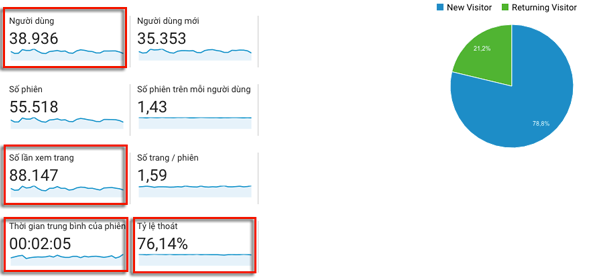
"User" This number can often be interpreted as "unique user" or "unique visitor." This means that individuals have access to and view your blog.
For example, a person may have visited your blog and viewed 4 pages, then returned 3 days later and viewed 1 page, and then returned 2 weeks later and viewed 10 pages. They still count as only one user.
So, that number will tell you how many people have viewed your blog over a one-month period. This is very important for tracking your blog traffic growth. The next month is higher than last month is a good sign.
"Pageviews," Google Analytics will count each post, referrer, contact page, homepage ... as a single page on your blog.
If a user views 4 pages per visit or 10 visits, only one page is viewed (for example, they read article A 10 times in that month). All of these pages will be accrued and accumulated by Google Analytisc throughout the process for which you are viewing the report. This number is as high as possible.
"Average time of the session" you can also understand is the on-time time on the blog. These numbers are as high as possible, ie they can read your posts from start to finish, or they move from one page to another without ever leaving.
Next you can look at the chart to see the new visitor (returning visitor)
The 50/50 ratio will be the best, at the bottom of the report you can see that the number of new visitors is quite high (78%), this is very good it shows that the SEO strategy is quite active. good. However, Ngoc wants old users to come back to the blog more.
So surely Ngoc will need to take note of strategies to increase the amount of old traffic returned by such as remarketing, or optimizing email list building , reviewing email auto-split scenarios. Read more articles on the fanpage ... to navigate old users back to the blog.
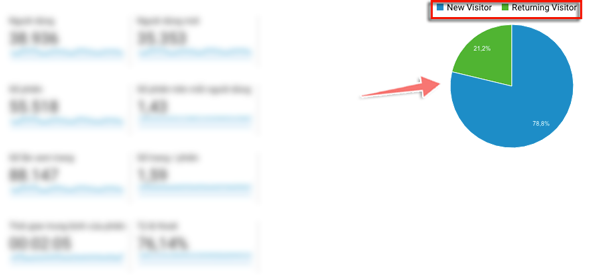
Percentage of new & returning users returning to the blog
In this section, you can also compare the reporting period with the previous period to assess the growth of the blog by ticking "Compare to: Previous period"

Comparative figures in% will begin to be displayed and if the majority are blue as shown above, congratulations on your blog growth. Conversely, if the numbers are red then you need to look into more details and find solutions.
The following will be more detailed parameters and solutions ...
HOW DO PEOPLE GET TO YOUR BLOG? (ACCESS CHANNEL)
Have you ever wondered how users get to your blog? Google Analytics lets you know very well.
To view a user's traffic source, simply go to "Conversions" -> "All traffic" -> "Channels".
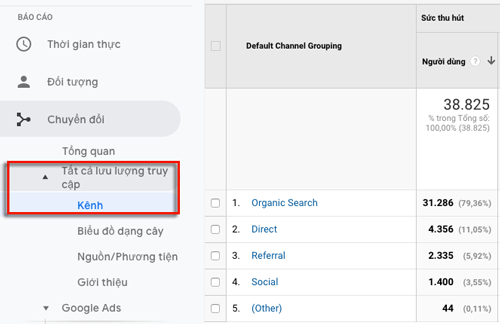
Here you will see all the channels that users visit the blog, which usually will have:
- Organic Search: A natural search, that is, a user searches for a particular keyword on Google. If this number is high then you are implementing a pretty good SEO strategy, your content is well ranked on the search engines. Let's continue to implement SEO strategy ...
- Direct: This number tells you that users have entered your blog (domain) URL into the browser bar, or they have bookmarked the blog, click the link in the email. This proves you are doing a good job of building a personal brand. If you are a blogger and want to develop your personal brand, the higher the number, the better. It proves that the user has started to remember and is watching you.
- Referal: Referral source, this indicator is extremely important. It shows that the user has visited your blog by clicking on a link on another website. This number is as high as it shows other websites are talking about you, you also have the backlink from them. If this number is low then you will probably need a strategy and posting guest posts on other blogs is the best way to get you started.
- Social: This is a social network, which is the source of traffic from Facebook, Youtube, Instagram ... This data will help you know which of your target users are most social. And what social networks are you focusing on?
Look at all these sources of traffic and you will see what you are doing well and the channels (sources) that you will need to focus more on. You can also click on each channel to see more details.
For example, for referral sources, Ngoc can see the highest traffic coming from a search engine cup (Google still counts as a website), which reflects the search volume on search results. The cup to the blog is pretty high.
But more importantly here are other websites and blogs. Ngoc will see the blog funnyhocweb.com and Ngoc will click to see the details of the articles that have brought users to.
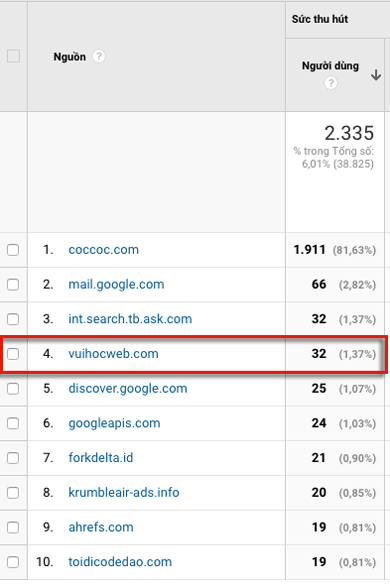
This is all the posts, click on the arrow icon next to the URL.
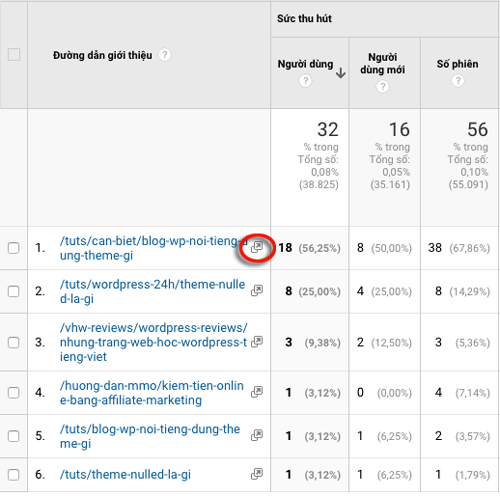
Ngoc will see the article as below, here blog owner Vuihocweb.com has placed 2 links to the blog of Ngoc in the article "What is the famous WordPress blog theme?"
This shows Ngoc's blog being mentioned and appreciated by other bloggers. Through this analysis, Ngoc will need to send a thank-you letter, continue to build a better relationship with them to further increase the introductory articles.
WHAT ARE THE CHARACTERISTICS OF YOUR BLOG? (DEMOGRAPHIC)
Understanding and knowing the details of users such as age, gender, place of living, interests ... will help you have a better marketing strategy, blog content.
Google Analytisc will give you all this data to the bottom of your hair.
Now let's see how old your visitors are.
Go to "Audiences" -> "Demographics" -> "Age", where you'll see all ages ranked from high to low according to traffic.
Through analysis Ngoc found that users from 18 to 34 is the age group visited the most blogs, this reflects accurately because the blog Ngoc Com then Dot Com writes a lot about the topic of making money online, building a passive income So this is the group of users who are in the process of making money "pulses and pulses" most! 😉
They are young people so content will need proper construction, and if technically inclined they can still attract them.

See what their gender is. 65% are men, perhaps the upcoming Jade will need to further increase the content towards women. Since basically making money online at home and blogging women are doing very well.

Some types of content Ngoc will prepare in the coming time will be: 10 ways to make money online at home for women, 5 topics suitable blog and potential for mothers with children ...
Next, you also need to see where the user is from, in which city, by moving to "Geography" -> "Location"

Not surprisingly, 95% of the blog's users are from Vietnam, click on the country to see which city they live in.
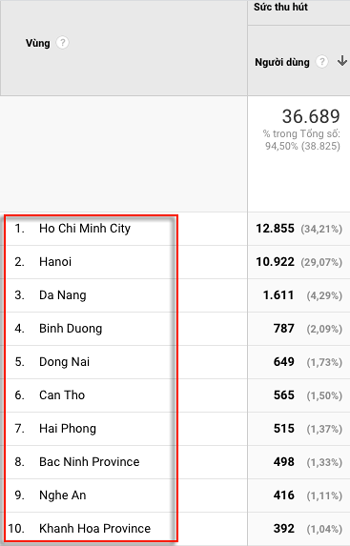
These are the cities where users live. What does this help you?
When you run ad campaigns on Facebook, all of these demographic data will help you target them accurately, meaning you'll reach out to people who have already visited them. Your blog is over.
WHAT KIND OF CONTENT DO USERS SEARCH AND LIKE THE MOST ON YOUR BLOG?
This is a very important indicator. You need to know exactly what types of content users are reading the most and what keywords they find.
To see the most searched keywords on your blog, go to "Conversions" -> "Search Console" -> "Queries"
Here you will find all the most searched keywords on your blog, Ngoc realized that keyword brand "ngocdenroi" is the most used and is a sign that shows the strategy of branding. Individuals are doing well.
However, Ngoc sees a problem that the keywords related to BLOG are weak, so surely the kind of content that needs to be pushed further is:
- A guide to making money by blogging
- Build and write professional blogs
- Write a blog full time
- ...
Next Ngoc need to see which pages the user most viewed? Skip to "Behavior" -> "Site Content" -> "All Pages"
Ngoc sees that the home page is the most visited site, which proves that users are searching for many brand keywords on Ngoc's blog and Google is taking them to the home page.
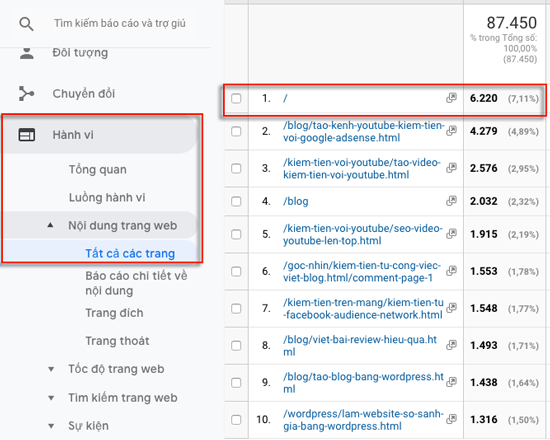
Then you can also go to "Behavior" -> "Behavior Flow" to see the details of how users navigate from landing page to another page, and finally where they exit.

All of this will help you find ways to retain and navigate your blog longer.
Now, continue to see which pages are the ones with the highest bounce rates. Go to "Behavior" -> "Site Content" -> "Exit Pages".
These will be the ones with the highest exit rates.

Ok, now go to these pages to adjust the content or add dynamic callouts, internal linking links ... for example, in the image below Jade added a call-to-action on the bounce rate page. high.
HOW TO GET PROACTIVE NOTIFICATIONS FROM GOOGLE ANALYTICS
Normally, to track Google Analytics stat indexes, you will need direct access, but Google Analytics gives you an option to set up proactive email alerts.
This way you can also set up the metrics you want Google Analytics sent to you. To set up notifications you go to "Admin"
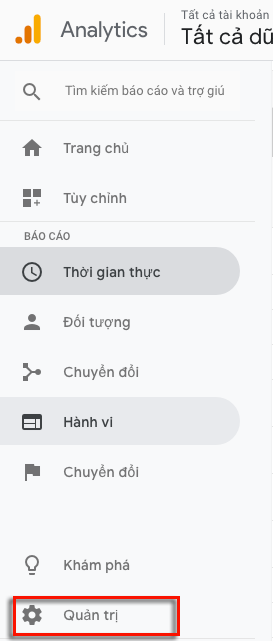
Continue to the "Custom Alerts" section.

Click the "New alert" button.

Now you can name the alert, set the parameters, conditions you want to receive alerts.

The example above Ngoc will be set up if the number of sessions drops by more than 10% from the previous week, and then receives a reminder email from Google Analytics.
EPILOGUE
Google Analytics is extremely powerful and completely free. It gives you loads of detailed user data to help you understand them better.
From understanding them, you'll know how to create content that they like, where they care, where they live, what social networks they use, what phones and operating systems they use. Bring your content to "put in front of them" ...
Even understanding the sources of traffic, the channels also show you how to increase marketing reach to reach more readers.
The ultimate goal is to grow your blog more and more powerful, provide more value and be true to what your readers are most interested in.
- Useful for you: Use Google Search Console to Optimize SEO for Blogs: 6 secrets that few people disclose to you!
Have you installed and integrated Google Analytics in your blog? How often do you track Google Analytics metrics? And how do you use these parameters to optimize and develop your blog? Jade wants to get more of your share under the comment!
Do not forget to help Ngoc share this article to your friends nhé!




Post a Comment
Post a Comment